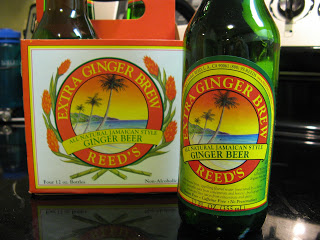 I recently had a chance to try a gluten-free beverage that was previously unfamiliar to me – ginger beer. The brand was Reed’s, and the flavor was Extra Ginger Brew (the company makes 6 different flavors…all variations on ginger). The brews are non-alcoholic, and brewed directly from roots, fruits, herbs and spices. In the words of Reed’s, the company is reviving “the lost art of brewing soft drinks.” (As opposed to modern day soft drink production, which typically involves bottling, carbonation, high fructose corn syrup, colorings, and flavorings.)
I recently had a chance to try a gluten-free beverage that was previously unfamiliar to me – ginger beer. The brand was Reed’s, and the flavor was Extra Ginger Brew (the company makes 6 different flavors…all variations on ginger). The brews are non-alcoholic, and brewed directly from roots, fruits, herbs and spices. In the words of Reed’s, the company is reviving “the lost art of brewing soft drinks.” (As opposed to modern day soft drink production, which typically involves bottling, carbonation, high fructose corn syrup, colorings, and flavorings.)
As the name of the flavor implies, the Extra Ginger Brew has…you guessed it…extra ginger, for some added kick above and beyond Reed’s regular formula. They weren’t kidding. I found the ginger to be a bit overwhelming. It was too strong a flavor. But I saw potential, and suspect I’d really enjoy a cold bottle of toned-down ginger beer. (By comparison, a ginger ale – as opposed to ginger beer – would be more mellow than even the mellowest ginger beer.) In the end, it’s a nice alternative to supermarket soft drinks, which I tend not to drink anyway.
Give Reed’s a try, and if you happen to sample some of the other five flavors, please do weigh in and let us know what you think!
– Pete
I’ve been drinking this for a while, and I just tried their cherry brew. It was delicious. The Extra Ginger is still my favorite. I’m a big fan of ginger ale, and when I can extra ginger I am an extremely happy girl. Reed’s is the brand I recommend to other ginger lovers. I’m glad you found it and liked it too!
Thanks for chiming in, Amanda! The cherry brew flavor caught my eye, and I’m looking forward to trying it.
Cheers, Pete
Hey Pete–Ah, this post brings back some very fond memories! The first time we were introduced to ginger beer was in Bermuda in 1984. (Hubby sailed to Bermuda from Annapolis in a 33-foot sailboat in a race. I flew in to meet him.) Bermudians use it with their wonderful Black Seal rum to make a drink called a Dark and Stormy. Delish. We usually have ginger beer in our liquor cabinet, but I confess I like it best in a Dark and Stormy. We need to make another trip to Bermuda to get some Black Seal rum though. 😉
Shirley
Hey Shirley. I’m going to have to try a Dark and Stormy! What ratio do you use?
Cheers, Pete
Pete–You deserve one! After Maren is asleep, fix one for Kelli, too. 🙂
Like most drinks, there are different proportions. Try these below and then figure out what you like best. I like using a glass with some room for “play,” so I can add more ginger beer if I want to. (Sort of along the lines of making a rum and coke … just depends on how strong you like it.)
http://www.goslingsrum.com/recipe_detail.asp?RecipeID=192
http://www.novusvinum.com/spirits/rum/goslings_blackseal.html
I take it you found some Black Seal rum. Of course, you can use other rum, but it’s not quite the same.
We love Bermuda. 🙂 Sometime I’ll tell you about our Swizzle experience there. 😉
Enjoy!
Shirley
Thanks for the info, Shirley! Look forward to trying one!
Cheers, Pete
I like all the Reed’s ginger beers a lot and the Extra Ginger is my favorite. I put ginger in almost everything I cook.
I have really enjoyed reading your beer posts. My husband is also a home brewer, but he hasn’t yet tried to make a GF beer. Thanks for all the info on the subject, especially about malting the millet.
I had a couple of questions about that. Was it not terribly tedious de-sprouting and de-rooting all those teeny weeny grains, and how did you accomplish that? Could you simply cut back a little on the sprouting time and not let it grow so much?
Also what other grains would support yeast? Teff? Amaranth? Quinoa? (Just found your blog tonight, searching for GF in Santa FE. We live in Alamogordo and are visiting SF this week. Going to Pranzo’s for Mushroom Ragu on Creamy Polenta, MMMM)
Hi Harmonious… Removing the roots and shoots from the sprouted millet involved some work, but wasn’t overly tedious. I kilned it to dry them out, tumbled them in a sack in the dryer, and then sifted them on a mesh screen a couple of times.
You can’t hold back on the sprouting too much, otherwise the malted millet doesn’t develop sufficient enzymes for conversion during the mash.
Several other gluten-free grains can be malted and brewed with good success – quinoa and buckwheat especially. Most folks use unmalted rice and corn. Sorghum is a) difficult to obtain and b) develops cyanide compounds in the roots and shoots, so you have to be careful to fully remove them.
Let me know if you have any other questions!
Cheers, Pete